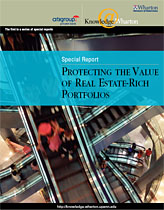Looking for more insights?
Sign up to stay informed about our latest article releases.
Long-term real estate mortgage rates have remained at attractively low levels, but they likely won't stay resilient to rising short-term rates forever. Experts from The Citigroup Private Bank and Wharton look at the market forces affecting the U.S. commercial real estate market and consider the potential impact an overheated market and rising rates could have on investors and the economy at large.

Sign up to stay informed about our latest article releases.